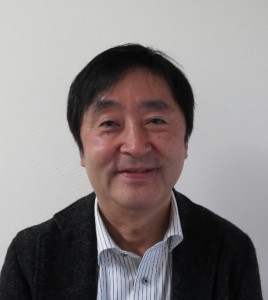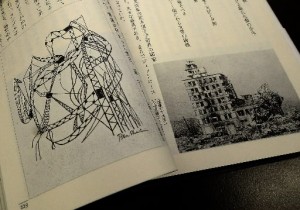Son of A-bomb survivor spotlights Ben Shahn: American artist depicted cruelty of atomic bombing
Jan. 27, 2015
Musashi University professor publishes book: Building in Hiroshima served as motif for picture
by Shigeru Sakata, Staff Writer
A son of an atomic bomb survivor has published a book on the career of American painter Ben Shahn (1898-1969), who was known for his works of social realism. Kozo Nagata, 60, is a professor at Musashi University in Tokyo. In the belief that a building that was destroyed in the A-bombing of Hiroshima served as the motif for some of Mr. Shahn’s works, Mr. Nagata examined the premise that Mr. Shahn recognized the inhumanity of nuclear weapons soon after the war, leading him to produce works critical of nuclear tests.
A former producer for NHK, Mr. Nagata produced programs on the Daigo Fukuryu Maru (Lucky Dragon No. 5) and the Pacific War. He took an interest in works by Mr. Shahn that were critical of nuclear testing, and spent about a year gathering materials for his book starting in April 2013.
He was particularly interested in a tempera painting titled “Renascence” that Mr. Shahn did in 1946, the year after the atomic bombing. The painting depicts a woman gazing uneasily at a structure. A lithograph titled “Many Cities from the Rilke Portfolio,” which featured a nearly identical structure, appeared in a collection of his art published the year before Mr. Shahn died.
Many works by Mr. Shahn are housed at the Fukushima Prefectural Museum of Art. Research by Yasuko Araki, a curator there, revealed that a photograph taken in Hiroshima just after the atomic bombing provided the motif for the structure. Based on materials in the Hiroshima Peace Memorial Museum, Mr. Nagata determined that the building was the Odamasa Store, a kimono wholesaler in Ebisu-cho, Naka Ward.
The three-story shop was destroyed, with only its twisted steel frame remaining. Mr. Nagata believes that it was this scene that Mr. Shahn depicted using distinctive wavy lines.
The collection of Mr. Shahn’s works includes a line from “The Notebooks of Malte Laurids Brigge,” a novel by Rainer Maria Rilke: “To write a single line of verse one must see many cities, people, things…” Although there is no record of Mr. Shahn commenting on Hiroshima or Nagasaki, Mr. Nagata supposes that Mr. Shahn recognized the cruelty of nuclear weapons and wanted to make all artists aware of Hiroshima. Mr. Nagata’s book, which was published by Otsuki Shoten, is on sale for 2,800 yen.
(Originally published on January 12, 2015)
by Shigeru Sakata, Staff Writer
A son of an atomic bomb survivor has published a book on the career of American painter Ben Shahn (1898-1969), who was known for his works of social realism. Kozo Nagata, 60, is a professor at Musashi University in Tokyo. In the belief that a building that was destroyed in the A-bombing of Hiroshima served as the motif for some of Mr. Shahn’s works, Mr. Nagata examined the premise that Mr. Shahn recognized the inhumanity of nuclear weapons soon after the war, leading him to produce works critical of nuclear tests.
A former producer for NHK, Mr. Nagata produced programs on the Daigo Fukuryu Maru (Lucky Dragon No. 5) and the Pacific War. He took an interest in works by Mr. Shahn that were critical of nuclear testing, and spent about a year gathering materials for his book starting in April 2013.
He was particularly interested in a tempera painting titled “Renascence” that Mr. Shahn did in 1946, the year after the atomic bombing. The painting depicts a woman gazing uneasily at a structure. A lithograph titled “Many Cities from the Rilke Portfolio,” which featured a nearly identical structure, appeared in a collection of his art published the year before Mr. Shahn died.
Many works by Mr. Shahn are housed at the Fukushima Prefectural Museum of Art. Research by Yasuko Araki, a curator there, revealed that a photograph taken in Hiroshima just after the atomic bombing provided the motif for the structure. Based on materials in the Hiroshima Peace Memorial Museum, Mr. Nagata determined that the building was the Odamasa Store, a kimono wholesaler in Ebisu-cho, Naka Ward.
The three-story shop was destroyed, with only its twisted steel frame remaining. Mr. Nagata believes that it was this scene that Mr. Shahn depicted using distinctive wavy lines.
The collection of Mr. Shahn’s works includes a line from “The Notebooks of Malte Laurids Brigge,” a novel by Rainer Maria Rilke: “To write a single line of verse one must see many cities, people, things…” Although there is no record of Mr. Shahn commenting on Hiroshima or Nagasaki, Mr. Nagata supposes that Mr. Shahn recognized the cruelty of nuclear weapons and wanted to make all artists aware of Hiroshima. Mr. Nagata’s book, which was published by Otsuki Shoten, is on sale for 2,800 yen.
(Originally published on January 12, 2015)









